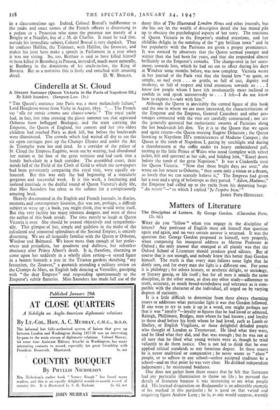Cinderella at St. Cloud
A Distant Summer (Queen Victoria in the Paris of Napoleon III.) By Edith Saunders. (Sampson Low. 15s.)
"THE Queen's entrance into Paris was a most melancholy failure," Lord Houghton wrote from Vichy in August, 1855. ". .. The French say elle est entrée comme une chauve-souris.' " The royal yacht had, in fact, lost time crossing the glassy summer sea that separated Osborne from beflagged Boulogne, and the train carrying the Emperor, the Queen of England, her consort and her two eldest children had reached Paris as dusk fell, but before the boulevards were illuminated. The crowds which had waited all day to see the six open carriages pass up the Champs Elysees and under the Arc de Triomphe were hot and tired. In a corridor of the palace of St. Cloud the Empress Eugenie, worn out by waiting, had abandoned her station at the foot of the great staircase and had sunk into a handy bath-chair in a back corridor. The assembled court, their minds full of the Field of the Cloth of Gold to which the newspapers had been persistently comparing this royal visit, were equally ex- hausted. But this was only the bad beginning of a singularly gorgeous and successful week. .It is this week, a fascinating and isolated interlude in the dutiful round of Queen Victoria's daily life, that Miss Saunders has taken as the subject for a conspicuously amusing book.
Heavily documented in the English and French journals, in diaries, memoirs and contemporary histories, this was not, perhaps, a difficult subject to write up ; a book, you might think, that would write itself. But this very facility has many inherent dangers, and most of these the author of this book avoids. The time merely to laugh at Queen Victoria is over. She should be treated objectively and sympathetic- ally. This glimpse of her, simple and guileless in the midst of the calculated and contorted splendours of the Second Empire, is entirely disarming. We are all languidly familiar with the Queen at Osborne, Windsor and Balmoral. We know more than enough of her prefer- ences and prejudices, her goodness and dullness, her relentless obstinacy after Prince Albert's death. It is, therefore, charming to come upon her suddenly in a wholly alien setting—a seated figure in a bonnet beneath a tree in the Trianon gardens sketching " my favourites, the Zouaves," a snonarch attending a military review on the Champs de Mars, an English lady dancing at Versailles, gossiping with " the dear Empress " and responding spontaneously to the Emperor's subtle flatteries. Miss Saunders has made full use of the
dusty files of The Illustrated London News and other journals, but she has not let the wealth of descriptive detail she has mined pile up to obscure the psychological aspects of her story. The reactions of Queen Victoria to the Emperor's studied attentions, and her childlike delight in the sunshine of the "gay brilliant town". and in her popularity with the Parisians are given a proper prominence. It was noticed by observers that the Queen seemed younger and wittier than she had been for years, and that she responded almost brilliantly to the Emperor's remarks. The change-over in her senti- ments towards him, which he had set out to effect during his days at Windsor some months before, was now complete. Victoria wrote in her journal of the Paris visit that she found him " so quiet, so simple, so naif even . so gentle, so full of tact, dignity and
modesty, so full of respect and kind attentions towards us . I know few people whom I have felt involuntarily more inclined to confide in and speak unreservedly to . . . I felt—I do not kno* how to express it—safe with him."
Although the Queen is ,inevitably the central figure of this book and the one in whom we are most interested, the characterisations of the Emperor and the Empress, General Canrobert and other per- sonages connected with the visit are carefully constructed ; nor are the generally quizzical but enthusiastic swarms of Parisians along the hot boulevards left dim. Yet it is to the Queen that we again and again return—the Queen meeting Eugene Delacroix ; the Queen listening to Napoleon III's reminiscences of Madame Campan ; the Queen at the tomb of Napoleon I, gazing by torchlight and during a thunderstorm at the coffin under its heavy embroidered pall, turning to the little Prince of Wales who stood (complete with velvet jacket, kilt and sporran) at her side, and bidding him, " Kneel down before the tomb of the great Napoleon." It was a Cinderella treat for Queen Victoria. " Now that those bright days are over," she wrote on her return to Osborne, " they seem only a vision or a dream, so lovely that we can scarcely believe it." The Empress had given her a rose and a sprig of heliotrope as they parted. "Adieu, Madame," the Emperor had called up to the yacht from his departing barge. " Au revoir"—" to which I replied ' respere hien.'" JAMES POPE-HENNESSY.


































 Previous page
Previous page